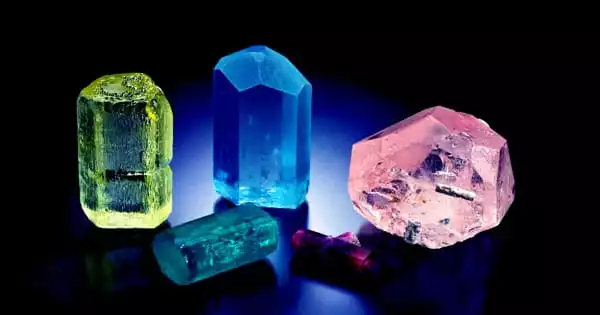What is Beryl?
Beryl is a beryllium aluminum silicate mineral with the chemical formula Be3Al2Si6O18. Emerald and aquamarine are two well-known beryl types. Hexagonal beryl crystals can grow to be many meters in length in nature, however terminated crystals are uncommon.
General Information
| Category | Cyclosilicate |
| Formula | Be3Al2Si6O18 |
| Crystal system | Hexagonal |
| Crystal class | Dihexagonal dipyramidal (6/mmm) |
Physical Properties of Beryl
- Lustre: Vitreous, Sub-Vitreous, Waxy, Greasy
- Colour: Colorless, green, blue, yellow, white, pink, etc.
- Streak: White
- Hardness: 7½ – 8 on Mohs scale
- Tenacity: Brittle
- Cleavage: Imperfect/Fair {0001}
- Fracture: Conchoidal
- Density: 2.63 – 2.92 g/cm3 (Measured)
History
Beryl was well-known in ancient times. The name “beryl” comes from the Ancient Greek word “beryllos,” which was originally used to describe all green gemstones but is now solely used for beryl. It has always been a mysterious stone. Its transparency was ideal for crystal gazing, allowing a seer’s vision of prophecy and future events to be exceedingly accurate.
Types of Beryl
Beryl is a very attractive and well-known mineral. It comes in a variety of hues and contains a number of valuable gemstone variants. Emerald, a green variant, is one of the most valuable stones. Emerald is only used to deep green Beryl; light green Beryl is just referred to as “Green Beryl” (or Heliodor if it has a yellowish color.)
Beryl is colorless in its purest form, but impurities give it a broad spectrum of hues and variants. Emerald’s green hue is generally created by residues of the element chromium, whereas Aquamarine’s blue color is usually caused by iron. Another notable gemstone is aquamarine, which is a greenish-blue to blue form of Beryl. Beryl has some of the world’s biggest natural crystals, with massive crystals discovered in many pegmatite occurrences.
Sources
Beryls may be found all around the world. Each beryl variety’s encyclopedia entry includes detailed geographical information.
California, Maine, South Dakota, Utah, Colorado, North Carolina, Connecticut, Idaho, and New Hampshire are among the states where goshenite may be discovered. Canada, Mexico, Brazil, and Russia are also home to this species.

Beryl and your Physical Health
Beryl has a cleansing and liver stimulating impact, as well as a nervous system balancing effect. It aids in the treatment of myopia and other stress-related disorders. After long-term healing and emotional release therapy, Beryl calms. It helps women during menopause.
Beryl and your Feelings
Beryl boosts bravery, reduces tension, and soothes the mind. It helps you avoid being overpowered by worry by reducing the impulse to over-analyze things. Beryl helps you rediscover your love for yourself and your relationship. This stone helps to balance long-term changes by calming and aligning the emotional body.
Uses of Beryl
- Scientific Uses of Beryl : For many years, the mineral beryl has been used in the manufacture of wire, but it has also been employed in space shuttles. Beryl includes beryllium, an extremely rare element found in just around 100 minerals. As a result, it is extremely important to the scientific community, as well as a wide range of other uses.
- Historical Uses of Beryl: The first documented usage of beryl was in Egyptian antiquity, while it is thought that it was used far earlier. It has long been regarded as a valuable stone, and it may be found in ornamental jewelry, weaponry, and clothes.
Final Thought
Beryl is known as the stone of triumph. It has uplifting and light energies that can help you relax and cope with your tension and worry. It’ll work as a sedative, which can come in handy when you’re feeling stressed or overwhelmed. Beryl will provide you with strength and balance, as well as open your mind to new possibilities! It will assist you in tuning in to the stone’s energies for direction.





